Leader - Crew Endurance
The Crew Starts With You
Creating a Culture of Crew Endurance Excellence
Operational effectiveness depends on crew endurance and crew endurance is about ensuring our people are healthy, fit, and rested to perform at their optimal level. If crew members are overly fatigued, mission accomplishment, performance, and safety are in jeopardy. Morale suffers. When applied and managed properly, crew rest acts as a force multiplier.
Prioritizing sleep requires a change in culture but also a commitment to lead by example. Find out today what you can do to help yourself and your crew.
"When the Boss Doesn't Feel Rested - the Whole Unit Pays a Price!"
The average adult needs 7 - 9 hours of quality sleep daily
Click on the buttons below to see how the amount of sleep you get over a two-week period will affect your cognitive performance
Hours of Sleep Per Night
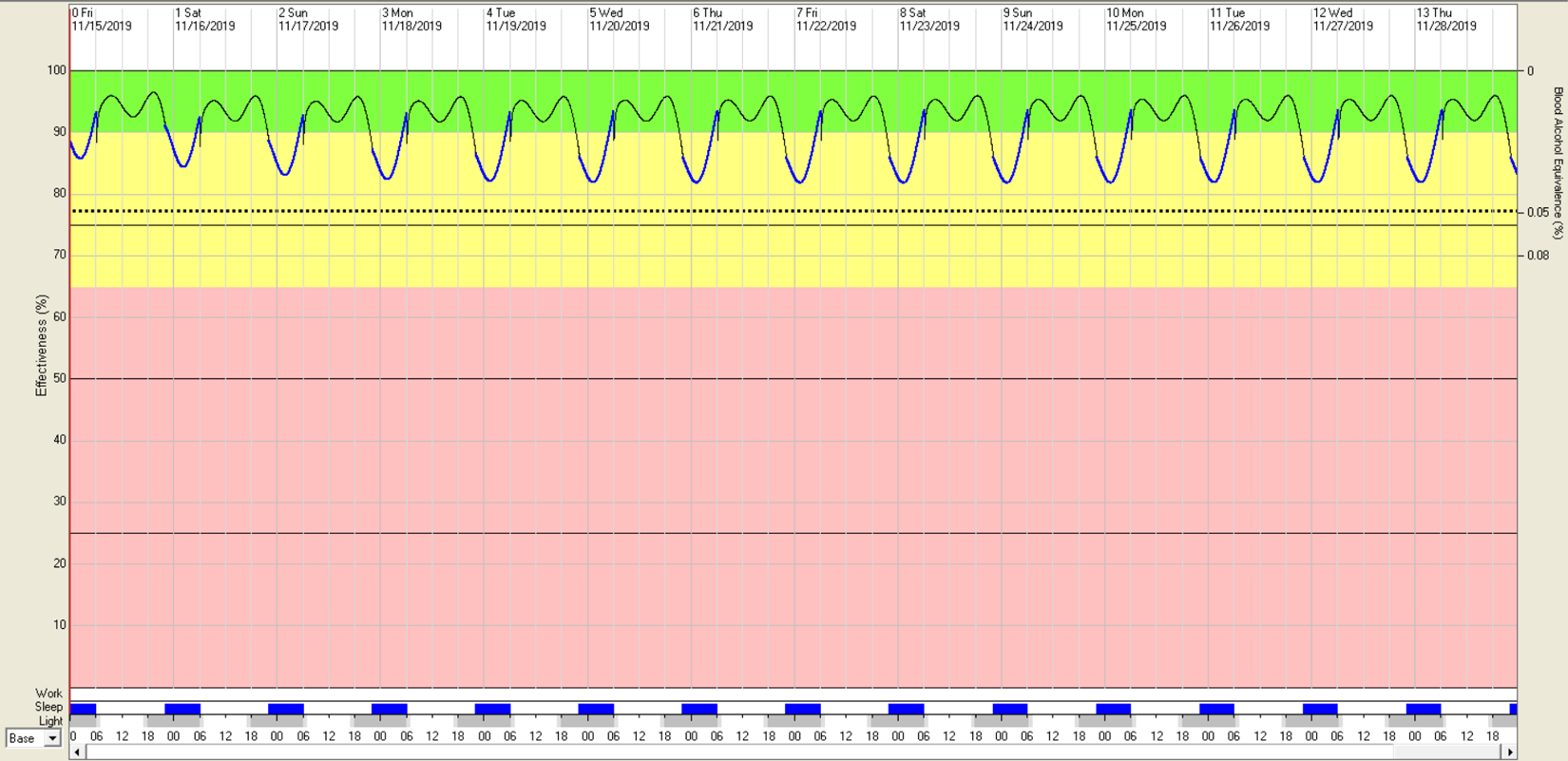
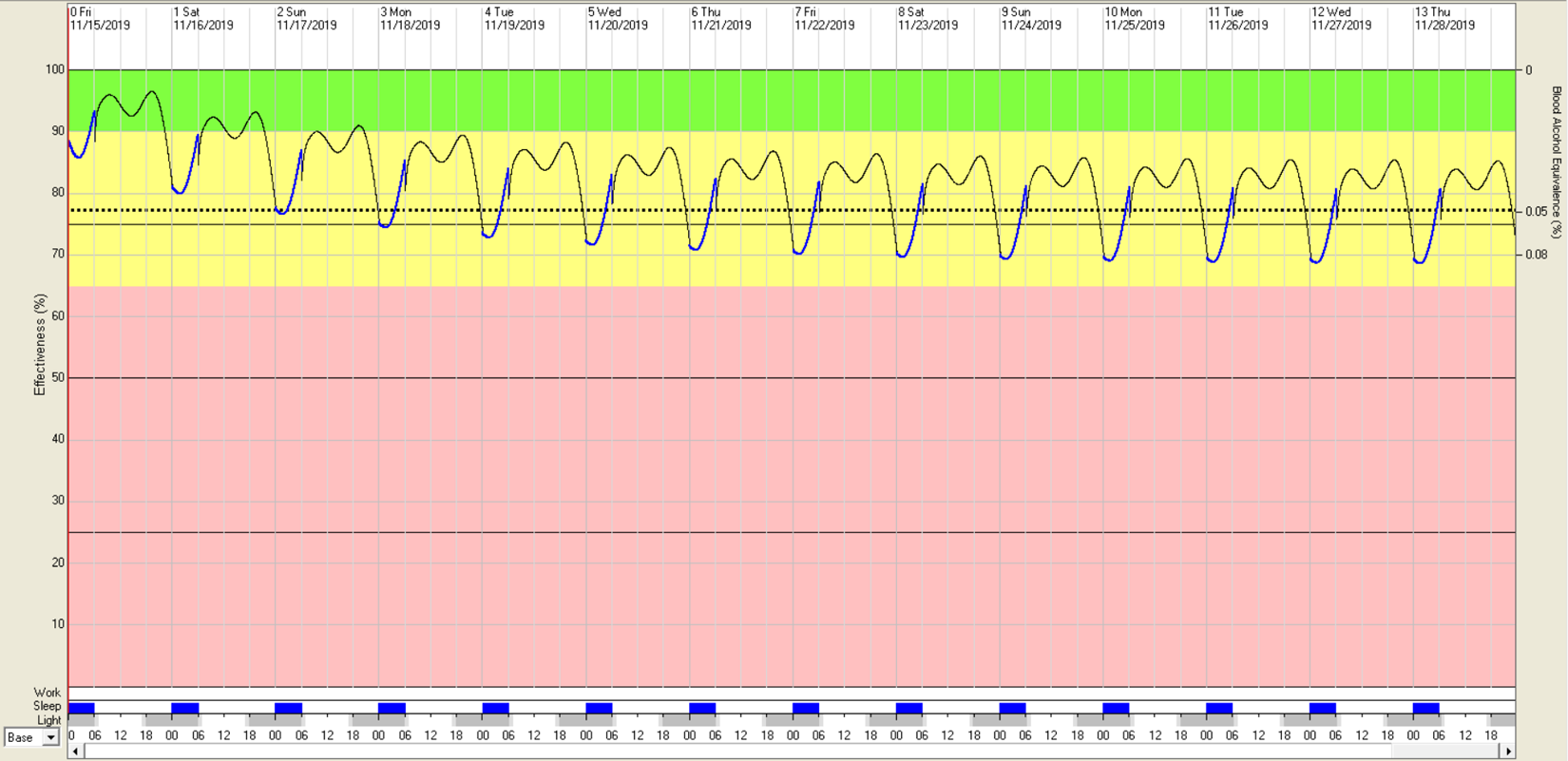
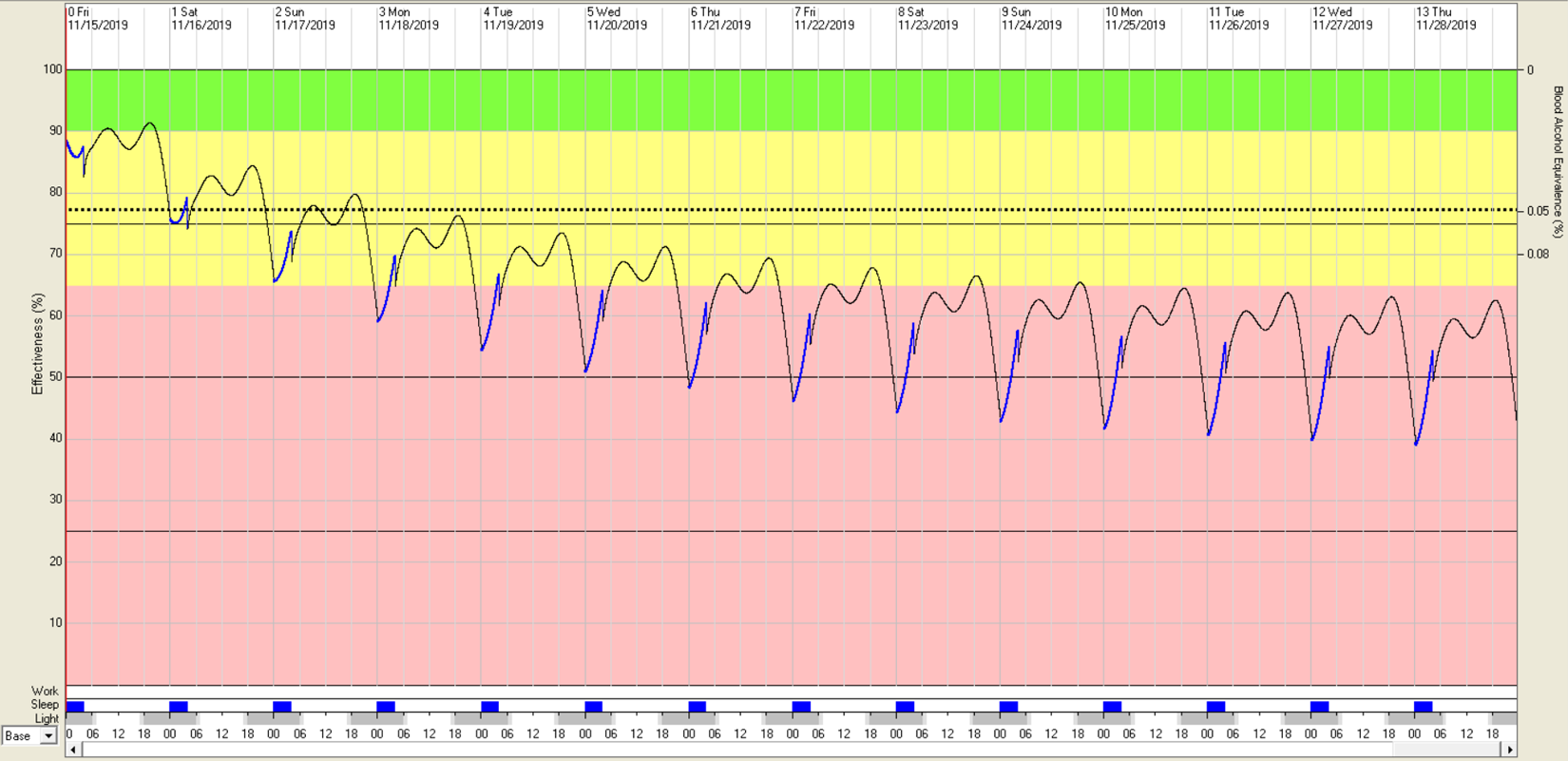
Keep Your Team Rested and Ready
Increase your Sailors endurance using a method with proven results - Circadian-Based Watchstanding Schedules. Numerous shipboard studies have shown how a circadian-based watchbill can improve operational readiness, enhance productivity, reduce stress and improve morale, especially over a long deployment.
The basics of a rested crew include:
- A focus on alert and engaged watchstanders
- Continued learning and understanding of the effects of good sleep practices amongst leadership and the crew
- Use of the 24-hour circadian rhythm to set the foundation for yourself and your crew
- The establishment of a stable daily work schedule including a watchbill that maximizes rest opportunities at the same time each day
- Requesting supporting analysis
Several circadian-based watchbills exist to help ensure that crew and staff are well rested and better prepared to perform their duties.
Become familiar with some of the watchbills and their characteristics before choosing a schedule for your crew.
Use These Watchbills
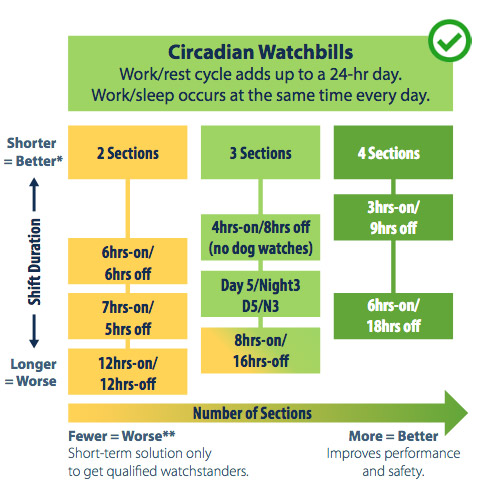
Avoid These Watchbills
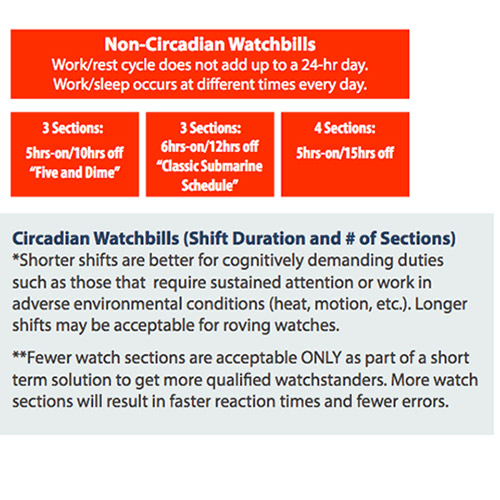
Considerations for Implementation of Watchbills
- Circadian-based rotations are almost always better
- For rotation times cardinal points are simpler; use the hours of 12, 3, 6 & 9 on an analog clock face
- Forward is better for the direction of rotations; staying up and sleeping in an hour longer is easier than going to bed and waking up an hour earlier
- There should be three weeks or more in each rotation; some ships wait until port call to shift
- Weekends generally allow more flexibility with Sunday or holiday schedule for the day of rotation change
- Lengthen the Day by an hour or so, rather than making a drastic change; shifting 6 hours takes about a week to completely adjust
- Rotate forward when possible
- Shorter is better
- It is easier to maintain alertness for 3 vs 6 hours
- A 4 section watch is better than 2 or 3 section
- Consider cross rate qualification to increase flexibility
- Design the workday so that the watch and rest are included in the plan
- Establish adequate meal hours; galley hours may need to be extended to support a new watchbill
- Establish which personnel need to attend drills, briefs, and debriefs and when to hold them
- Focus major briefings and all hands evolutions on periods between breakfast and dinner
- Make allowances to support watch schedules such as extended supply and admin hours
- Sleep should occur at the same time each day; work with the body's natural 24-hour rhythm
- Putting the same watch team together in berthing can reduce noise and unnecessary sleep disruptions
- The first few days on a new schedule pose higher risk for night watchstanders
- Make sure the night watchstanders have the opportunity for prophylactic napping prior to standing watch
- Use PHEL curves to determine limitations for hot environments
- The 3/9 rotation is ideal to stay below PHEL curves
- Crisp turnover procedures are important for circadian-based watchbill success
- Consider using a short paper or laminated checklist to speed up and standardize the process
- If required, consider that pre-watch plant tours will lengthen turnover time
- Ensure your watch team has adequate time to bond - circadian watches enable long term alignment of watch team
Crew Endurance Handbook
The Crew Endurance Handbook is your guide to applying circadian-based watchbills
The handbook shares valuable lessons learned through scientific investigation. It also gives examples of past watchbills that have been used effectively.
Put Crew Endurance Knowledge To Work
Discover five ways to optimize your ship
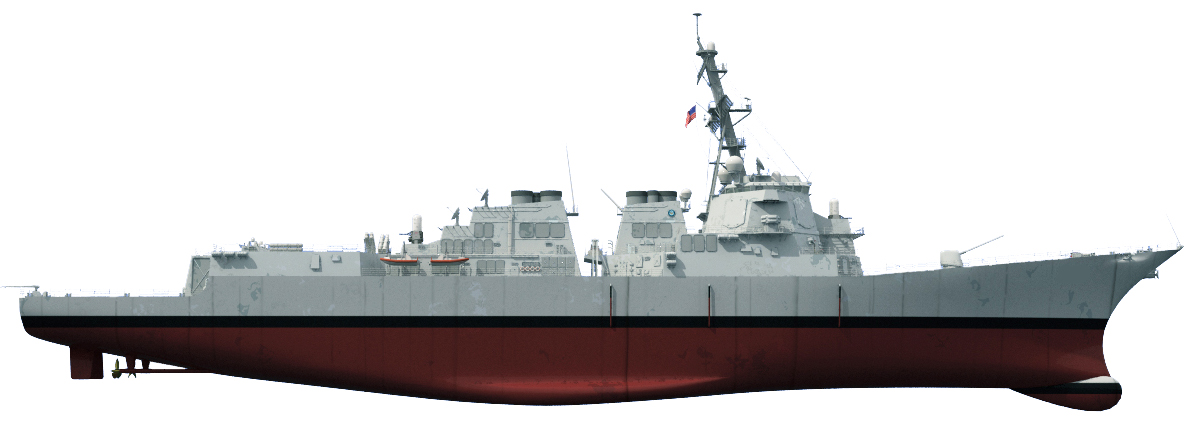
Circadian-Based Watchbills
- A circadian-based watchbill is a term used for a work and rest schedule that conforms to a 24-hour day, allowing individuals to work, eat, and sleep at approximately the same time each day
- When you combine the number of hours spent on watch with the number of hours off watch, a circadian-based system will add up to 24 hours
- The system aligns with the naturally-occuring 24-hour rhythm which drives all biological process, down to the cellular level
- Numerous shipboard studies have shown reduced stress and improved operational readiness, morale, and productivity with the implementation of circadian-based watchbills
- Choose the right watchbill. There are several circadian-based watch schedules, each with merits and tradeoffs. Become familiar with the variations between watchbills before deciding which is best for your crew and/or contact us for a consultation.
Light Management
- Provide HEV light exposure for night watchstanders prior to watch
- Enhance lighting at beginning of watch where possible
- Provide blue-blocking lenses if finishing a shift when the sun is coming up
- Avoidance of bright light exposure if about to go to sleep
- Provide adequate curtains for berthing racks
- Provide dimly lit rest areas
Noise & Temperature Management
- Eliminate reveille to allow early morning watch standers to sleep in
- Eliminate taps allowing watchstanders who are sleeping to remain alseep
- Separate lounge areas from berthing areas
- Maintain cool temperature (62-65 Fahrenheit) for best sleep
- Limit needle gun usage and 1MC ship wide announcements during protected sleep periods
Nutritional Support
- Schedule meal hours to support circadian-based watchbills
- Schedule meal hours to cover turnover times, ideally an hour either side
- Add a healthy meal at 0000 for night watch teams
Leadership Directives
- Establish strategies for providing mandatory protected sleep periods for each watch rotation i.e. protected from scheduled meetings, training, drills, etc
- Hold quarters later in the day or do not require quarters in the mornings for all hands. Consider midday quarters/Officers-call
- Maximize protected sleep periods prior to night watches
- Move evening prayer to lunchtime
- Hold the Ops/Intel brief in the afternoon
- Hold admin meetings between 0900 and 1600
- Set a good example to your crew - learn about, and practice, good sleep hygiene
How Much is Your Crew's Fatigue Costing?
The National Safety Council developed an easy-to-use online tool, where employers can receive an estimate of how much fatigue is costing their bottom line.
A consistently sleep deprived crew costs money from loss of productivity and increased healthcare costs.
Supporting a culture of good sleep is not just beneficial for individual health but also for the overall readiness of the Navy.
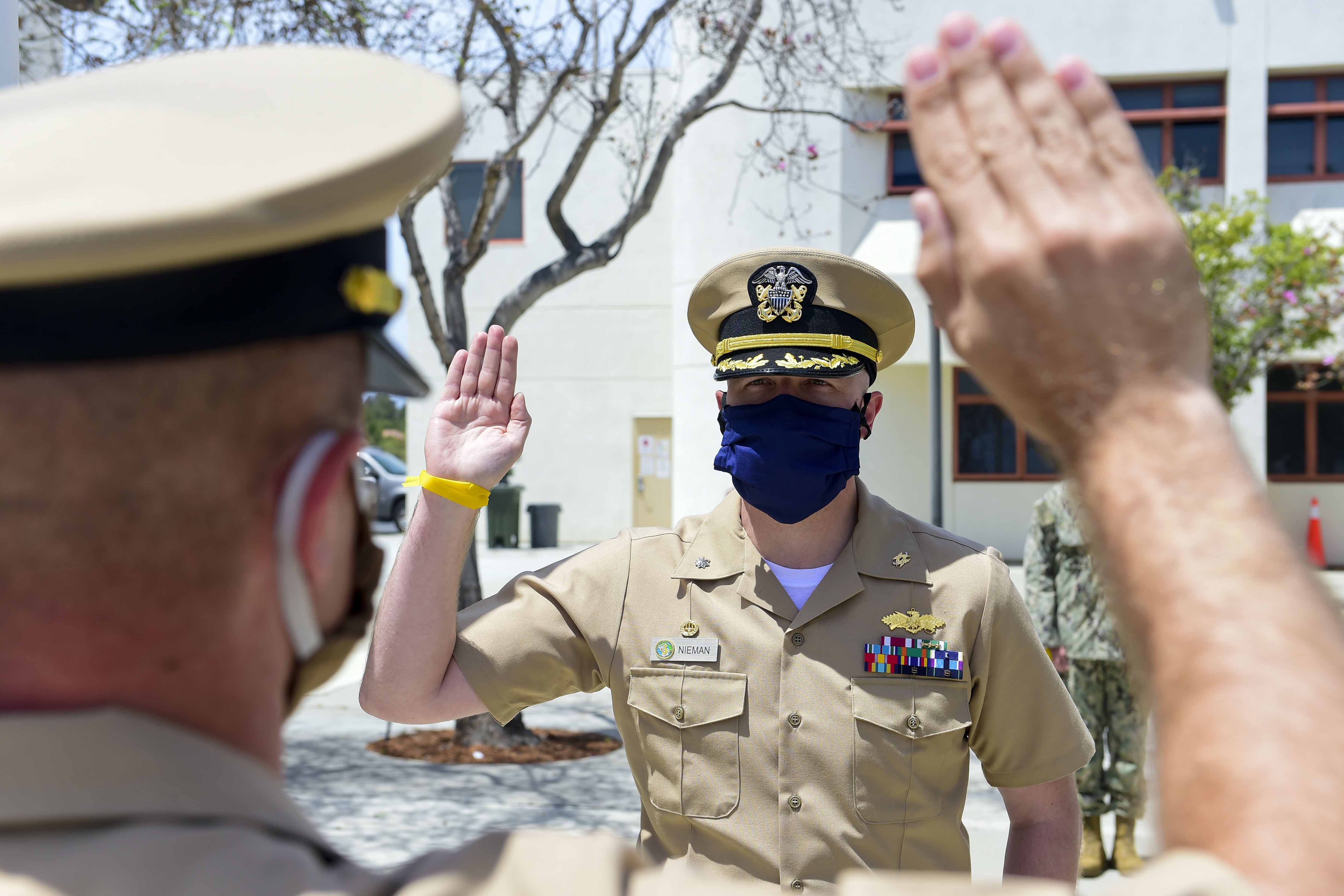
We implemented the 3/9 Circadian watch rotation on deployment and I saw an immediate uptick in watchstander alertness on the bridge. People were more focused, less fatigued, and the stable routine made them more effective.
- Capt John Cordle, USS SAN JACINTO (CG 56)
We did this throughout all of my command tours. I liked it - I felt I had a more alert and ready watch team, and that their recovery periods were more productive.
- Capt Mark Scovill, USN; CO of USS TORTUGA, USS GUNSTON HALL and IWO ARG Commodore
I know that there's lots of medical side effects to just not having a good, regular sleep pattern. The crew loved it…I saw a great response.
- Commander Seth Burton, USS SCRANTON (SSN 756)
